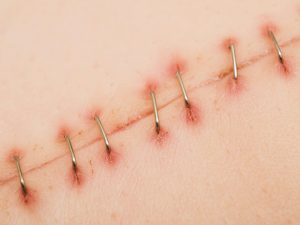- Home
- Editorial
- News
- Practice Guidelines
- Anesthesiology Guidelines
- Cancer Guidelines
- Cardiac Sciences Guidelines
- Critical Care Guidelines
- Dentistry Guidelines
- Dermatology Guidelines
- Diabetes and Endo Guidelines
- Diagnostics Guidelines
- ENT Guidelines
- Featured Practice Guidelines
- Gastroenterology Guidelines
- Geriatrics Guidelines
- Medicine Guidelines
- Nephrology Guidelines
- Neurosciences Guidelines
- Obs and Gynae Guidelines
- Ophthalmology Guidelines
- Orthopaedics Guidelines
- Paediatrics Guidelines
- Psychiatry Guidelines
- Pulmonology Guidelines
- Radiology Guidelines
- Surgery Guidelines
- Urology Guidelines
The future of sutures and staples: A hydrogel sealant

Although sutures and staples have been used for decades to close wounds or surgical incisions, both have their drawbacks: suturing can be time-consuming and can lead to extended and costly procedures, while staples are limited to use during open procedures and can cause tissue damage upon insertion, which can lead to infection. Additionally, neither offers a waterproof seal and are much stiffer than tissue, which can cause damage over time.The study is published in New England Journal of Medicine.
Researchers in Jeffrey Karp's lab at Brigham and Women's Hospital turned to nature in hopes for a better solution. The team was inspired by the Dusky Arion slug's elastic defensive slime. The slime, a mucus-based multicomponent glue that makes the slug bond to surfaces and difficult to remove, is 97 percent water and contains two intertwined polymers with a net negative charge and positively charged proteins. Using the slime as a model, the team created a dissipative hydrogel with both ionically and covalently cross-linked polymers with a net negative charge and a bridging polymer that contained coupling reagents with a net positive charge. This resulted in the creation of an adhesive material that mediates strong interfacial contact and can stretch without breaking.
The researchers found that this new adhesive conforms and adheres strongly to the skin, cartilage, and arteries; closes holes in heart tissue, and stops bleeding from the lesioned liver tissue.

Disclaimer: This site is primarily intended for healthcare professionals. Any content/information on this website does not replace the advice of medical and/or health professionals and should not be construed as medical/diagnostic advice/endorsement or prescription. Use of this site is subject to our terms of use, privacy policy, advertisement policy. © 2020 Minerva Medical Treatment Pvt Ltd